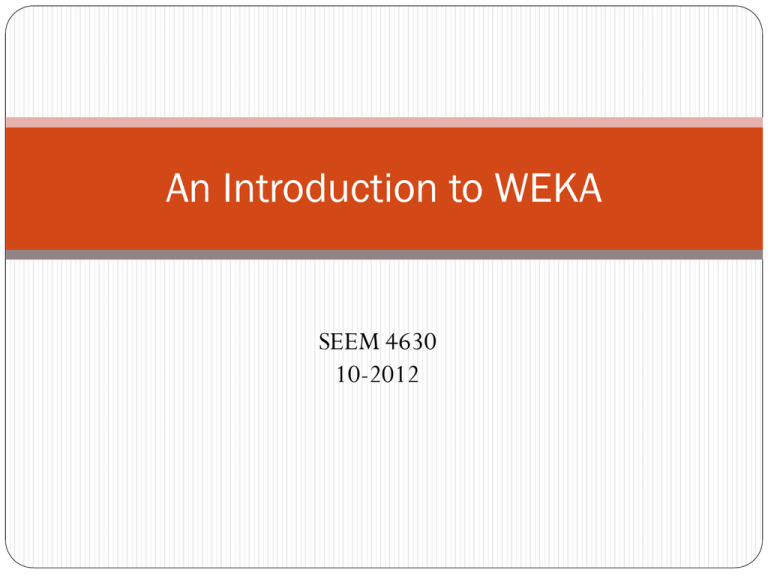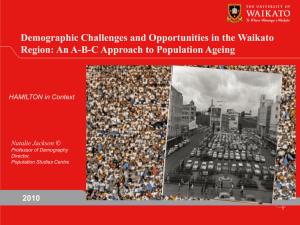
An Introduction to WEKA
SEEM 4630
10-2012
Content
What is WEKA?
The Explorer:
Preprocess data
Classification
Clustering
Association Rules
Attribute Selection
Data Visualization
References and Resources
2
4/13/2015
What is WEKA?
Waikato Environment for Knowledge Analysis
It’s a data mining/machine learning tool developed by
Department of Computer Science, University of Waikato, New
Zealand.
Weka is also a bird found only on the islands of New Zealand.
3
4/13/2015
Download and Install WEKA
Website:
http://www.cs.waikato.ac.nz/~ml/weka/index.html
Support multiple platforms (written in java):
Windows, Mac OS X and Linux
WEKA has been installed in the teaching labs in SEEM
4
4/13/2015
Main Features
49 data preprocessing tools
76 classification/regression algorithms
8 clustering algorithms
3 algorithms for finding association rules
15 attribute/subset evaluators + 10 search algorithms
for feature selection
5
4/13/2015
Main GUI
Three graphical user interfaces
“The Explorer” (exploratory data analysis)
“The Experimenter” (experimental
environment)
“The KnowledgeFlow” (new process model
inspired interface)
6
4/13/2015
Content
What is WEKA?
The Explorer:
Preprocess data
Classification
Clustering
Association Rules
Attribute Selection
Data Visualization
References and Resources
7
4/13/2015
Explorer: pre-processing the data
Data can be imported from a file in various formats: ARFF,
CSV, C4.5, binary
Data can also be read from a URL or from an SQL database
(using JDBC)
Pre-processing tools in WEKA are called “filters”
WEKA contains filters for:
Discretization, normalization, resampling, attribute selection,
transforming and combining attributes, …
8
4/13/2015
WEKA only deals with “flat” files
@relation heart-disease-simplified
@attribute age numeric
@attribute sex { female, male}
@attribute chest_pain_type { typ_angina, asympt, non_anginal, atyp_angina}
@attribute cholesterol numeric
@attribute exercise_induced_angina { no, yes}
@attribute class { present, not_present}
@data
63,male,typ_angina,233,no,not_present
67,male,asympt,286,yes,present
67,male,asympt,229,yes,present
38,female,non_anginal,?,no,not_present
...
9
4/13/2015
WEKA only deals with “flat” files
@relation heart-disease-simplified
@attribute age numeric
@attribute sex { female, male}
@attribute chest_pain_type { typ_angina, asympt, non_anginal, atyp_angina}
@attribute cholesterol numeric
@attribute exercise_induced_angina { no, yes}
@attribute class { present, not_present}
@data
63,male,typ_angina,233,no,not_present
67,male,asympt,286,yes,present
67,male,asympt,229,yes,present
38,female,non_anginal,?,no,not_present
...
10
4/13/2015
11
University of Waikato
4/13/2015
12
University of Waikato
4/13/2015
13
University of Waikato
4/13/2015
14
University of Waikato
4/13/2015
15
University of Waikato
4/13/2015
16
University of Waikato
4/13/2015
17
University of Waikato
4/13/2015
18
University of Waikato
4/13/2015
19
University of Waikato
4/13/2015
20
University of Waikato
4/13/2015
21
University of Waikato
4/13/2015
22
University of Waikato
4/13/2015
23
University of Waikato
4/13/2015
24
University of Waikato
4/13/2015
25
University of Waikato
4/13/2015
26
University of Waikato
4/13/2015
27
University of Waikato
4/13/2015
28
University of Waikato
4/13/2015
29
University of Waikato
4/13/2015
30
University of Waikato
4/13/2015
31
University of Waikato
4/13/2015
Explorer: building “classifiers”
Classifiers in WEKA are models for predicting nominal or
numeric quantities
Implemented learning schemes include:
Decision trees and lists, instance-based classifiers, support
vector machines, multi-layer perceptrons, logistic regression,
Bayes’ nets, …
32
4/13/2015
Decision Tree Induction: Training Dataset
This follows
an example
of Quinlan’s
ID3 (Playing
Tennis)
33
age
<=30
<=30
31…40
>40
>40
>40
31…40
<=30
<=30
>40
<=30
31…40
31…40
>40
income student credit_rating
high
no fair
high
no excellent
high
no fair
medium
no fair
low
yes fair
low
yes excellent
low
yes excellent
medium
no fair
low
yes fair
medium
yes fair
medium
yes excellent
medium
no excellent
high
yes fair
medium
no excellent
buys_computer
no
no
yes
yes
yes
no
yes
no
yes
yes
yes
yes
yes
no
April 13, 2015
Output: A Decision Tree for “buys_computer”
age?
<=30
31..40
overcast
student?
no
no
34
yes
yes
yes
>40
credit rating?
excellent
fair
yes
April 13, 2015
36
University of Waikato
4/13/2015
37
University of Waikato
4/13/2015
38
University of Waikato
4/13/2015
39
University of Waikato
4/13/2015
40
University of Waikato
4/13/2015
41
University of Waikato
4/13/2015
42
University of Waikato
4/13/2015
43
University of Waikato
4/13/2015
44
University of Waikato
4/13/2015
45
University of Waikato
4/13/2015
46
University of Waikato
4/13/2015
47
University of Waikato
4/13/2015
48
University of Waikato
4/13/2015
49
University of Waikato
4/13/2015
50
University of Waikato
4/13/2015
51
University of Waikato
4/13/2015
52
University of Waikato
4/13/2015
53
University of Waikato
4/13/2015
54
University of Waikato
4/13/2015
55
University of Waikato
4/13/2015
56
University of Waikato
4/13/2015
57
University of Waikato
4/13/2015
Explorer: finding associations
WEKA contains an implementation of the Apriori algorithm
for learning association rules
Works only with discrete data
Can identify statistical dependencies between groups of
attributes:
milk, butter bread, eggs (with confidence 0.9 and support
2000)
Apriori can compute all rules that have a given minimum
support and exceed a given confidence
61
4/13/2015
Basic Concepts: Frequent Patterns
Tid
Items bought
10
Beer, Nuts, Diaper
20
Beer, Coffee, Diaper
30
Beer, Diaper, Eggs
40
Nuts, Eggs, Milk
50
Nuts, Coffee, Diaper, Eggs, Milk
Customer
buys both
Customer
buys diaper
itemset: A set of one or more items
k-itemset X = {x1, …, xk}
(absolute) support, or, support count of X:
Frequency or occurrence of an itemset
X
(relative) support, s, is the fraction of
transactions that contains X (i.e., the
probability that a transaction contains X)
An itemset X is frequent if X’s support is
no less than a minsup threshold
Customer
buys beer
62
April 13, 2015
Basic Concepts: Association Rules
Tid
Items bought
10
Beer, Nuts, Diaper
20
Beer, Coffee, Diaper
30
Beer, Diaper, Eggs
40
50
Nuts, Eggs, Milk
Nuts, Coffee, Diaper, Eggs, Milk
Customer
buys both
Customer
buys beer
63
Customer
buys
diaper
Find all the rules X Y with minimum
support and confidence
support, s, probability that a
transaction contains X Y
confidence, c, conditional probability
that a transaction having X also
contains Y
Let minsup = 50%, minconf = 50%
Freq. Pat.: Beer:3, Nuts:3, Diaper:4, Eggs:3, {Beer,
Diaper}:3
Association rules: (many more!)
Beer Diaper (60%, 100%)
Diaper Beer (60%, 75%)
April 13, 2015
64
University of Waikato
4/13/2015
65
University of Waikato
4/13/2015
66
University of Waikato
4/13/2015
67
University of Waikato
4/13/2015
68
University of Waikato
4/13/2015
69
University of Waikato
4/13/2015
Explorer: attribute selection
Panel that can be used to investigate which (subsets of)
attributes are the most predictive ones
Attribute selection methods contain two parts:
A search method: best-first, forward selection, random,
exhaustive, genetic algorithm, ranking
An evaluation method: correlation-based, wrapper, information
gain, chi-squared, …
Very flexible: WEKA allows (almost) arbitrary combinations
of these two
70
4/13/2015
71
University of Waikato
4/13/2015
72
University of Waikato
4/13/2015
73
University of Waikato
4/13/2015
74
University of Waikato
4/13/2015
75
University of Waikato
4/13/2015
76
University of Waikato
4/13/2015
77
University of Waikato
4/13/2015
78
University of Waikato
4/13/2015
Explorer: data visualization
Visualization very useful in practice: e.g. helps to determine
difficulty of the learning problem
WEKA can visualize single attributes (1-d) and pairs of
attributes (2-d)
To do: rotating 3-d visualizations (Xgobi-style)
Color-coded class values
“Jitter” option to deal with nominal attributes (and to detect
“hidden” data points)
“Zoom-in” function
79
4/13/2015
80
University of Waikato
4/13/2015
81
University of Waikato
4/13/2015
82
University of Waikato
4/13/2015
83
University of Waikato
4/13/2015
84
University of Waikato
4/13/2015
85
University of Waikato
4/13/2015
86
University of Waikato
4/13/2015
87
University of Waikato
4/13/2015
88
University of Waikato
4/13/2015
89
University of Waikato
4/13/2015
References and Resources
References:
WEKA website:
http://www.cs.waikato.ac.nz/~ml/weka/index.html
WEKA Tutorial:
Machine Learning with WEKA: A presentation demonstrating all graphical user
interfaces (GUI) in Weka.
A presentation which explains how to use Weka for exploratory data mining.
WEKA Data Mining Book:
Ian H. Witten and Eibe Frank, Data Mining: Practical Machine Learning Tools
and Techniques (Second Edition)
WEKA Wiki:
http://weka.sourceforge.net/wiki/index.php/Main_Page
Others:
Jiawei Han and Micheline Kamber, Data Mining: Concepts and Techniques,
2nd ed.









